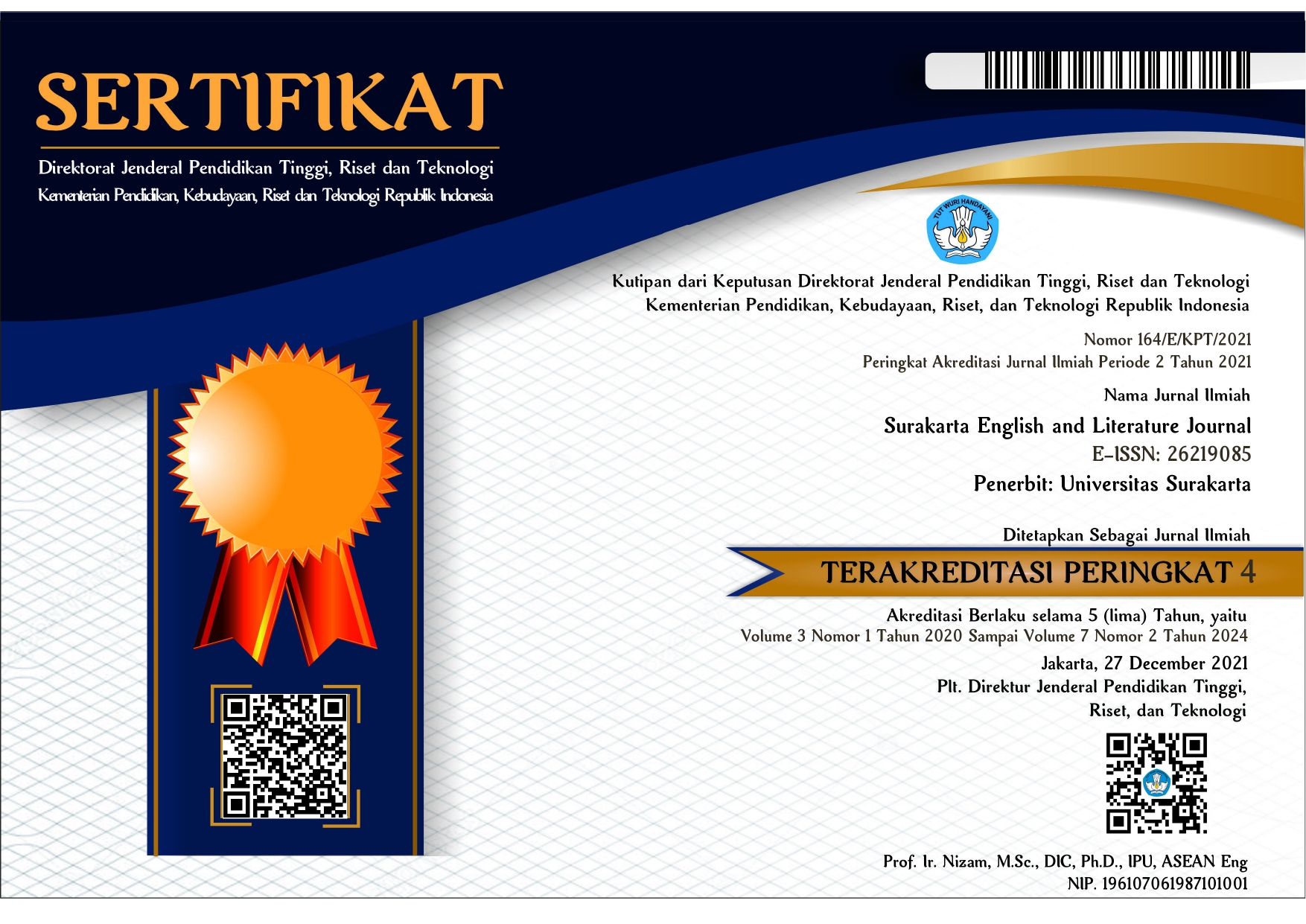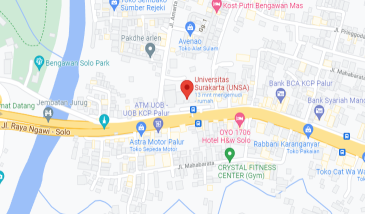Integrity, Pride and Love as Power in Jane Austen's Novel: Pride and Prejudice
DOI:
https://doi.org/10.52429/selju.v6i1.96Keywords:
politeness, personal power, referent power, social variablesAbstract
This study aims to find out that relative power (P) variables are not only social status, age, education and wealth. Another aim is to show that negative politeness strategies do not always belong to someone with higher social power. Relative power is one element of social variables that decides politeness strategies. Pride and Prejudice reveal that integrity, pride and love are also variables of relative power. They can also prove that though someone’s social status is not high and her social distance from another participant is asymmetric, she could have power over someone with higher social status. Power characterized by integrity, pride, belief, and freedom from being dominated is called personal power; meanwhile, it is a power determined by a good personality, attractive physical appearance, and referent power. This study uses a qualitative method, and the data is mainly from Pride and Prejudice. The main character of Pride and Prejudice shows us that integrity, pride, and love could be the variables of power deriving from Personal and Referent power. Those powers could develop and deepen relative power in social variables to be applied in politeness studies.
References
Bacha, M. S., Rustum, R., Umer, M., & Khan, K. A. (2021). The Pragmatic Concept of Politeness and Face Work by Different Linguistic Scholars. Multicultural Education, 7(1), 312–320. https://doi.org/10.5281/zenodo.5068670
Beebe, L., Takahashi, T., & Uliss-Weltz, R. (1990). “Pragmatic Transfer in ESL Refusals.” In Robin Scarcella, Elaine Andersen, and Stephen Krashen (eds.), Developing Communicative Competence in a Second Language. Developing Communicative Competence in a Second Language, January, 55–73.
Blitvich, P. G. C., & Sifianou, M. (2019). Im/politeness and discursive pragmatics. Journal of Pragmatics, 145, 91–101. https://doi.org/10.1016/j.pragma.2019.03.015
Blutner, R. (2016). Politeness: Some Universals in Language Usage. STUF - Language Typology and Universals, 42(1). https://doi.org/10.1515/stuf-1989-0124
Chunli, Z., & Nor, S. N. B. M. (2016). The Realization of the Speech Act of Refusals Among Chinese Efl. Journal of Education and Social Sciences, 4(9), 244–251.
Corresponding, H. Y. A. (2016). A Critical Review of Prominent Theories of Politeness. Advances in Language and Literary Studies, 7(6). https://doi.org/10.7575/aiac.alls.v.7n.6p.262
Cremona, M., Assimakopoulos, S., & Vella, A. (2017). the Expression of Politeness in a Bilingual Setting: Exploring the Case of Maltese English. Russian Journal of Linguistics, 21(4), 767–788. https://doi.org/10.22363/2312-9182-2017-21-4-767-788
Cutting, J., & Fordyce, K. (2020). Politeness and Impoliteness. Pragmatics, 5, 36–46. https://doi.org/10.4324/9781003010043-5
El-dali, H. M., El-Moety, D. M. A., & El-Seidi, M. A. (2020). Language and the Parameters of Power in Medical Discourse in Spoken Egyptian Arabic. Journal of Critical Studies in Language and Literature, 1(4), 28–40. https://doi.org/10.46809/jcsll.v1i4.40
Eshghinejad, S., & Moini, M. R. (2016). Politeness Strategies Used in Text Messaging: Pragmatic Competence in an Asymmetrical Power Relation of Teacher–Student. SAGE Open, 6(1). https://doi.org/10.1177/2158244016632288
Foley-Anthropological Linguistics_ An Introduction _ Wiley. (n.d.).
Houck and Gass_Interlanguage Refusals_ A Cross-cultural Study of Japanese-English - Noël Houck, Susan M. (n.d.).
How to Build the Confidence YoPersonal power_u Need to Be an Effective Leader, According to Body-Language Expert Amy Cuddy _ Inc. (n.d.).
Jasim Betti, M. (2020). Politeness and Face Threatening Acts in Iraqi EFL learners’ Conversations. Article in Glossa a Journal of General Linguistics, 3(8), 2020. https://www.researchgate.net/publication/344637114
Kurniawan, N. (2015). An Analysis of Positive and Negative Politeness Strategies in An Interview of Mark Rutte on Metro Tv’S Face 2 Face With Desi Anwar Program. Positive and Negative Politeness, 1–66.
Magee, J. C., & Smith, P. K. (2013). The Social Distance Theory of Power. In Personality and Social Psychology Review (Vol. 17, Issue 2). https://doi.org/10.1177/1088868312472732
Menge, T. (2018). The role of power in social explanation. In European Journal of Social Theory (Vol. 21, Issue 1). https://doi.org/10.1177/1368431017714426
Morand, D. A., & Lewin, A. Y. (1996). Dominance, interaction : Of and in egalitarianism organizational politeness sociolinguistic analysis and power. Organizational Science, 7(5), 544–556. http://www.jstor.org/stable/2635290
Nurul, N. A., Djatmika, Sumarlam, & Diah Kristina. (2022). Negative Politeness Strategy on Expressive Act of Rosiana Silalahi Talk Show. Surakarta English and Literature Journal, 5(2), 132–153. https://doi.org/10.52429/selju.v5i2.26
Oktriana, T. T. (n.d.). Politeness Strategy and Power in an Organization : Orders / Requests From the. 2010.
Padilla Cruz, M. (2008). Phatic utterances as face-threatening / saving acts or politeness strategies : A pragmatic reflection for their teaching in the L2 class. 25 Años de Lingüística Aplicada En España: Hitos y Retos, April 2008, 799–804.
Rasmussen, G. (1997). Meaning in interaction: An introduction to pragmatics. In Journal of Pragmatics (Vol. 28, Issue 2, pp. 253–261). https://doi.org/10.1016/s0378-2166(97)84203-8
Ratih, G. K. (2014). Robin Lakoff ’ S Politeness Principles. English Language Teaching, 21(13), 3.
Shakouri, N. (2014). Qualitative research: incredulity toward metanarratives. Journal of Education and Human Development, 3(2), 671–680. http://jehdnet.com/journals/jehd/Vol_3_No_2_June_2014/40.pdf
Shipps, A. W. (1968). Pride and prejudice. Notes and Queries, 15(4), 146. https://doi.org/10.1093/nq/15.4.146-c
Vanderveken, D. (1990). Meaning and Speech Acts: Volume I: Principles of language use.
Wang, J. (2018). Qualitative Research in English Language Teaching and Learning. Indonesian EFL Journal: Journal of ELT, Linguistics, and Literature, 4(2), 116–132. http://ejournal.kopertais4.or.id/mataraman/index.php/efi
Wessel, J. L., & Steiner, D. D. (2015). Surface acting in service: A two-context examination of customer power and politeness. Human Relations, 68(5), 709–730. https://doi.org/10.1177/0018726714540731
Wilson, R. (1985). Pride and Prejudice by Jane Austen. In Pride and Prejudice by Jane Austen. https://doi.org/10.1007/978-1-349-07480-8

Downloads
Published
How to Cite
Issue
Section
License
Copyright (c) 2023 Ratna Trihartanti

This work is licensed under a Creative Commons Attribution-ShareAlike 4.0 International License.
Licensing for Data Publication
-
Open Data Commons Attribution License, http://www.opendatacommons.org/licenses/by/1.0/ (default)
-
Creative Commons CC-Zero Waiver, http://creativecommons.org/publicdomain/zero/1.0/
-
Open Data Commons Public Domain Dedication and Licence, http://www.opendatacommons.org/licenses/pddl/1-0/













